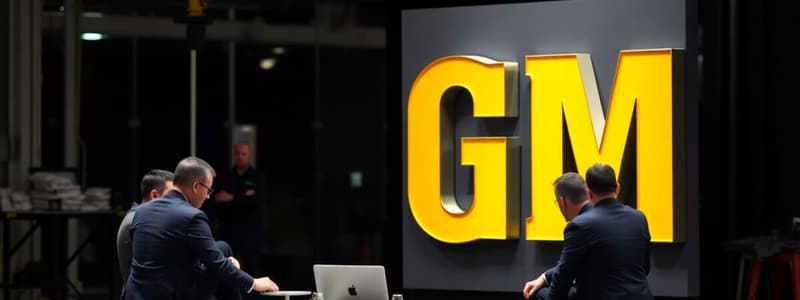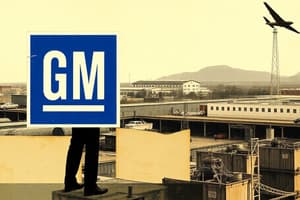Podcast
Questions and Answers
What do Great Man theories suggest about the nature of leadership?
What do Great Man theories suggest about the nature of leadership?
- Leadership can be learned through experience.
- Leadership qualities are inherent and individuals are born with them. (correct)
- Leaders are selected based on their education.
- Leadership styles are determined by the environment.
Which of the following is a challenge associated with trait theories of leadership?
Which of the following is a challenge associated with trait theories of leadership?
- They claim that leadership cannot be influenced by social skills.
- They do not account for the importance of situational factors.
- They assume all leaders share the same traits.
- Many individuals with leadership traits do not seek leadership roles. (correct)
How do contingency theories differ from trait theories?
How do contingency theories differ from trait theories?
- They argue that leadership can only be inherited.
- They emphasize the impact of the environment on leadership effectiveness. (correct)
- They identify specific traits that define a leader's character.
- They suggest that leadership traits are universal across all leaders.
Which trait is NOT typically associated with effective leadership according to trait theories?
Which trait is NOT typically associated with effective leadership according to trait theories?
What is a key belief of the Great Man theory regarding leaders?
What is a key belief of the Great Man theory regarding leaders?
What was a significant problem faced by the GM Fremont Plant in 1982?
What was a significant problem faced by the GM Fremont Plant in 1982?
Which of the following changes did management at NUMMI implement to address employee needs?
Which of the following changes did management at NUMMI implement to address employee needs?
What was the outcome of the productivity changes at NUMMI by 1986?
What was the outcome of the productivity changes at NUMMI by 1986?
How did the Sunbelt Strategy affect the environment of new GM plants?
How did the Sunbelt Strategy affect the environment of new GM plants?
What is a primary assumption of the infocracy model in management?
What is a primary assumption of the infocracy model in management?
Flashcards
GM Fremont Plant Problems
GM Fremont Plant Problems
High absenteeism (20%), unresolved grievances (2000), frequent wildcat strikes (3-4), high assembly costs (30% over Japan), and low productivity and quality.
GM NUMMI Plant Improvement
GM NUMMI Plant Improvement
Significant reduction in absenteeism (from 20% to 2%), resolved grievances, zero wildcat strikes, and improvements in productivity and product quality at the NUMMI plant.
Leadership Paradigm Shift
Leadership Paradigm Shift
A change in management approaches from an aristocracy/bureaucracy model with power concentrated to an infocracy that distributes power based on knowledge.
Key Process Contributors (KPC's)
Key Process Contributors (KPC's)
Signup and view all the flashcards
NUMMI Success Factors
NUMMI Success Factors
Signup and view all the flashcards
Great Man Theory
Great Man Theory
Signup and view all the flashcards
Trait Theories
Trait Theories
Signup and view all the flashcards
Contingency Theories
Contingency Theories
Signup and view all the flashcards
Situational Leadership
Situational Leadership
Signup and view all the flashcards
Management Styles
Management Styles
Signup and view all the flashcards
Study Notes
SKEMA Business School Leadership: Session 2
- Session focused on leadership, specifically relating to GM and NUMMI plants.
- Session included examples of different leadership theories.
- Also provided a case study of KIABI.
GM Leadership Problems
- GM's leadership had problems in 1950s.
- A new strategy, building plants in the South and Western US, prompted worker unrest.
- The new non-union plants were especially conflict-ridden.
- A cartoon illustration portrays the issues within GM.
GM Fremont Plant (1982)
- 5000 employees.
- 20% absenteeism.
- 2000 unresolved grievances.
- 5000 total annual grievances.
- 3-4 wildcat strikes.
- Chevrolet Nova product.
- Assembly costs 30% higher than those of Japan.
- Worst productivity and quality in GM.
NUMMI Plant (1986)
- 5000 employees (at the same time).
- 20% absenteeism.
- 2% absenteeism
- 2000 unresolved grievances.
- 500 total annual grievances.
- 3-4 wildcat strikes.
- Chevrolet Nova+Geo.
- Assembly costs (no change, 30% higher than those of Japan).
- Worst productivity in GM.
- Worst quality in GM.
Needs Met at NUMMI
- Employees needed to feel understood.
- Employees needed to feel valued.
- Additional needs were also assessed.
Paradigm Shifts in Management
- Aristocracy: Power distributed by lineage.
- Bureaucracy: Power distributed by gender and office.
- Infocracy: Power redistributed to key process contributors (KPCs).
Leadership Theories
- Presented various leadership theories: Great Man, Trait, Contingency, Situational, Behavioral, Participative Management, Relationship, and Management. Including additional theories, in definitions from an external resource in the text.
- A "diamond model of leadership" diagram is presented.
KIABI Vicenza Short Case
- Manager of women's/men's departments at KIABI in Vincenza, Italy.
- Top management initiated competition between all Italian KIABI stores' women's departments.
- Stores competing for highest sales progression from October 1st to December 31st.
- Winners rewarded with dinner & store advertisement.
- 5 young female employees involved.
- Employees met to formulate winning strategies.
Presentation Class Discussion
- Provided discussion on what makes a good and bad presentation.
Presentation Method (HLBT)
- Presented different methodology for digital presentations.
Summary Table (Quantitatitive data)
- Table showing progression data in percentage terms from different locations belonging to the KIABI group. Data presented.
Studying That Suits You
Use AI to generate personalized quizzes and flashcards to suit your learning preferences.




